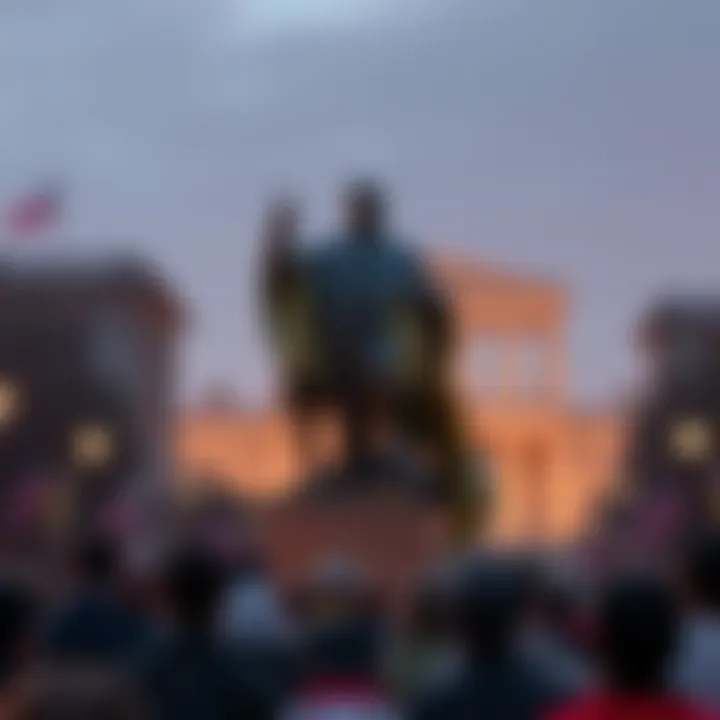Statue of Binance Founder CZ Heads to Washington DC | Trump Offers Pardon
Edited By
Carlos Silva

A statue commemorating Binance founder Changpeng Zhao, known as CZ, will soon grace Washington DC following a recent presidential pardon by Donald Trump. This unexpected move has ignited debates on public perception of cryptocurrency and its leaders, particularly in a city fraught with political tension.
Context of the Memorial
The installation of the statue comes at a time when crypto culture faces scrutiny from regulators. Many people view this as a bold statement supporting innovation amidst uncertainty, showcasing the rising significance of cryptocurrency within mainstream discussions. The timing is striking; some argue it symbolizes a shift in public sentiment toward digital currencies.
Key Reactions
Commenters on various forums voiced a mix of skepticism and humor. Comment highlights include:
"Any resemblance with Trojan horses is purely coincidental."
"It can go next to the one of Trump and Epstein."
These remarks suggest a playful, yet critical, perspective on how public figures interact with the crypto space.
Sentiment Patterns
Concerned Skepticism: Some people expressed unease about the implications of a statue honoring a crypto figure in a politically charged environment.
Humorous Takes: Others opted for lighthearted quips, reflecting a mix of frustration with the political climate and the absurdity of the situation.
Cynical Futility: A notable comment read, "I keep voting for Giant Meteor, but we're still here,” indicating a sense of hopelessness regarding political change.
"This sets a dangerous precedent for how public figures are celebrated," warned one commenter.
Implications of the Statue
This monument could spark discussions around the impact of crypto on modern economics and governance. It symbolizes a broader push towards acceptance of cryptocurrency amid regulatory challenges. The ongoing tension with regulators, exemplified by these recent developments, raises questions: Are monuments to controversial figures the best form of advocacy?
Key Highlights
🚀 CZ's statue signals increasing legitimization of crypto
💬 "How can I change to a different matrix? This one is broken" - opinion in the threads
⚖️ Trump’s pardon may amplify crypto's political entanglements
🎭 "Where’s Leroy Jenkins when you need him?" echoes the absurdity felt by many.
This developing story reflects a crossroads between cryptocurrency, politics, and public sentiment, suggesting that the future of digital currency could be as intertwined with national governance as it is with innovation.
Eyes on the Future: What's Next for Crypto?
There’s a strong chance that the statue of CZ will further ignite discussions about how cryptocurrencies fit into our economic future. As Bitcoin and other digital currencies face increased scrutiny, experts estimate that around 60% of people support tighter regulations amid concerns about market volatility. Additionally, we might see more public figures from the crypto scene stepping into political roles, along with potential new lobbying efforts for cryptocurrency-friendly legislation. The combination of a presidential pardon and a high-profile statue could signal a shift toward broader acceptance, especially if big-money investors begin to show confidence in the crypto market before the next election cycle.
Reflections from the Past: A Sculpture Similarity
In the 1930s, the installation of a statue of President Woodrow Wilson at Princeton University sparked a fierce debate around his controversial racial policies. Similar to today’s discussions about CZ, the honor was viewed by some as a celebration of legacy while others perceived it as a harmful reminder of past injustices. Just as that statue became a focal point for conversations surrounding race relations, so too may CZ’s statue become a cultural touchstone, reflecting the dual-edged nature of innovation and its often complex relationship with power. This parallel illustrates how society wrestles with honoring figures whose actions may not align with contemporary values, inviting ongoing critique and reflection about what such tributes say about us.
